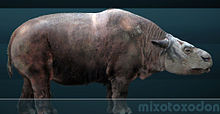Toxodonta
| Toxodonta Temporal range: Paleocene–Pleistocene |
|
|---|---|
 |
|
| Mixotoxodon | |
| Scientific classification | |
| Kingdom: | Animalia |
| Phylum: | Chordata |
| Class: | Mammalia |
| Superorder: | Meridiungulata |
| Order: | Notoungulata |
| Suborder: | Toxodonta |
| Families | |
|
†Homalodotheriidae |
|
†Homalodotheriidae
†Isotemnidae
†Leontiniidae
†Notohippidae
†Toxodontidae
Toxodonta or Toxodontia is a suborder of the meridiungulate order Notoungulata. Most of the members of the five included families, including the largest notoungulates, share several dental, auditory and tarsal specializations. The group is named after Toxodon, the first example of the group to be discovered by science.
Isotemnidae, the oldest and most primitive family of toxodonts, were generally large animals with larger canines than other early notoungulates. The family is probably paraphyletic or polyphyletic since only primitive dental features unite the 12 included genera, such as a complete dentition with unreduced canines and no diastemata in the earliest genera. Likewise, they are only weakly linked to other toxodonts by a few dental features, and their primitive cheek tooth pattern can be basal to all notoungulates except notioprogonians. The oldest of the 12 genera in this family is Isotemnus known from the Riochican-Casamayoran, but other genera are known from the Casamayoran, including Thomashuxleya, Pleurostylodon, and Pampatemnus. Of these, the sheep-sized Thomashuxleya is the best known; its skeleton shows that it was relatively robust, had limbs with reduced distal elongation, and five-hoofed feet with a large central digit.
...
Wikipedia
